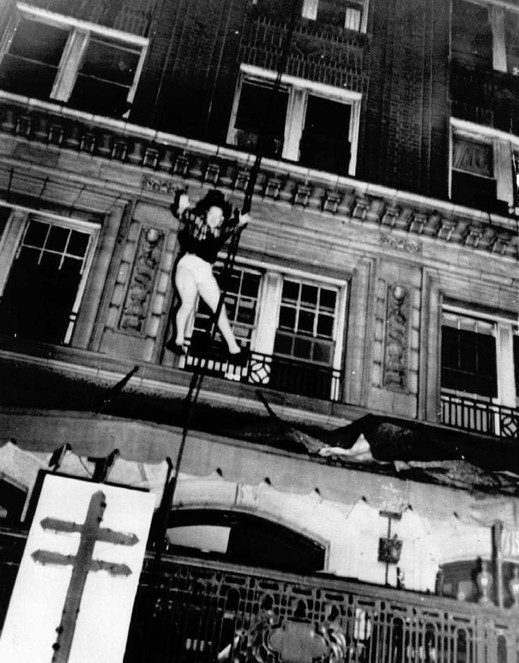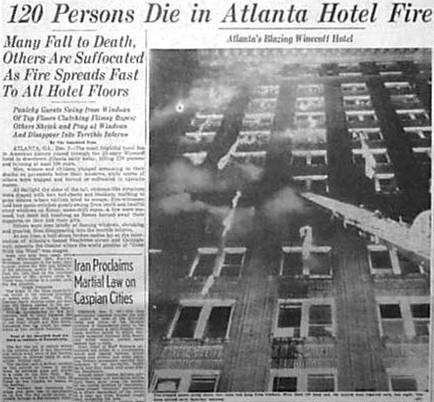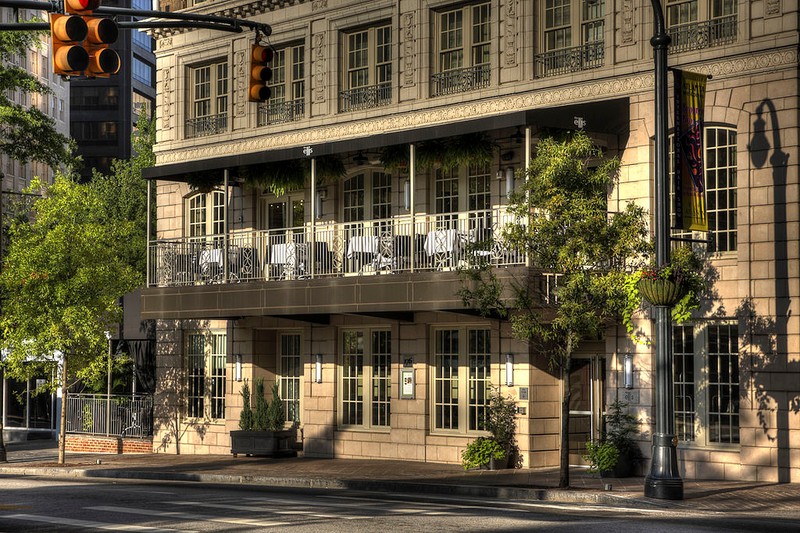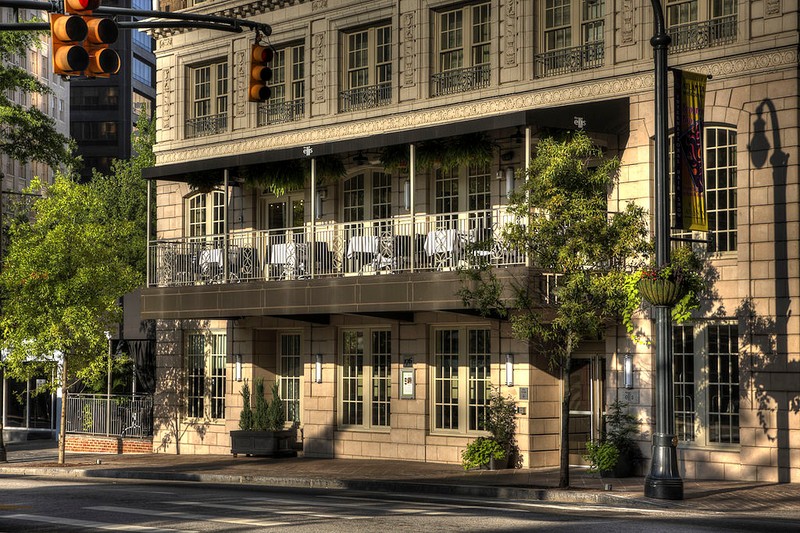Ellis Hotel and the Winecoff Hotel Fire of 1946
Introduction
Text-to-speech Audio
At fifteen stories high, the Winecoff Hotel was considered one of the first skyscrapers in Atlanta in 1913. It also claimed to be a fire proof building. However, on December 7, 1946 a large fire claimed the lives of 119 guests and staff. The tragedy remains the deadliest hotel fire in United States history. The hotel reopened in 1951 as the Peachtree Hotel along with numerous modifications and added safety features. The hotel is now the Ellis Hotel.
Images
Photo by Arnold Hardy of daisy McCumber jumping from the building to escape the flames. She lived to the age of 86 according to Clio user James Hoadley.

Newspaper report of that night.

The hotel reopened five years after the 1946 fire. It continues to operate as a hotel.


Backstory and Context
Text-to-speech Audio
Eerily similar to the audacity of those who built the "unsinkable Titanic," the Winecoff was constructed one year after the Titanic sunk, yet its builders boldly claimed the hotel was fireproof. Just a the Titanic was ill-prepared for a maritime disaster, the hotel did not have fire escapes, a sprinkler system, fire doors, or an alarm system. Worse, the only stairway hotel was wrapped around the elevator in the center of the building, which proved unusable during the fire. Wallpaper-lined walls allowed the fire to spread rapidly and made the hallways nearly impossible to navigate.1
All told, the 119 people that died, albeit in 1946, can attribute their deaths to the same audacity that accounted for many of the deaths associated with the Titanic that was built around the same time. In addition to the 119, another 90 were injured; roughly 209 of the 280 guests were injured or killed.2
Numerous people attempted to escape by jumping to nearby buildings, fashioning rope ladders out of bed sheets, or just jumping with hopes of landing safely (most died on impact). The inability for people to escape and the subsequent horrific deaths that resulted inspired President Truman to convene a commission intent on creating tougher standards for hotels regarding fire prevention and fire escapability measures.3
The origin of the fire has never been discovered. But, its legacy helped secure safer hotel fire-safety forever thereafter. Much of that resulting from a famous Pulitzer Prize winning photo by Arnold Hardy, an amateur photographer who famously had only one flash bulb remaining and caught, sadly, a women falling to her death. The Associated Press picked up the photo and it was then seen by the entire nation. It is one of many examples of how photojournalism highly affected culture from the 1930s to 1970s, when magazines such as Life Magazine grew to be very popular.
All told, the 119 people that died, albeit in 1946, can attribute their deaths to the same audacity that accounted for many of the deaths associated with the Titanic that was built around the same time. In addition to the 119, another 90 were injured; roughly 209 of the 280 guests were injured or killed.2
Numerous people attempted to escape by jumping to nearby buildings, fashioning rope ladders out of bed sheets, or just jumping with hopes of landing safely (most died on impact). The inability for people to escape and the subsequent horrific deaths that resulted inspired President Truman to convene a commission intent on creating tougher standards for hotels regarding fire prevention and fire escapability measures.3
The origin of the fire has never been discovered. But, its legacy helped secure safer hotel fire-safety forever thereafter. Much of that resulting from a famous Pulitzer Prize winning photo by Arnold Hardy, an amateur photographer who famously had only one flash bulb remaining and caught, sadly, a women falling to her death. The Associated Press picked up the photo and it was then seen by the entire nation. It is one of many examples of how photojournalism highly affected culture from the 1930s to 1970s, when magazines such as Life Magazine grew to be very popular.
Sources
1 Sam Heys and Allen B. Goodwin, The Winecoff Fire: The Untold Story of America's Deadliest Hotel Fire, (Atlanta: Longstreet Press, 1993), 1-7.
2 Stephen J. Spignesi, The 100 Greatest Disasters of All Time, (New York: Kensington Publishers, 2002), 268-9.
3 Heys and Goodwin, The Winecoff Fire, 1-7.
2 Stephen J. Spignesi, The 100 Greatest Disasters of All Time, (New York: Kensington Publishers, 2002), 268-9.
3 Heys and Goodwin, The Winecoff Fire, 1-7.
